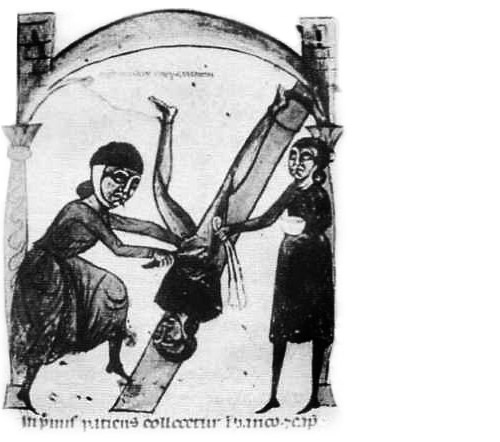Pubalgia’s Revenge 05Jul10

Medieval Hernia Surgery courtesy of Medscape.
You may not know this, but I’ve been injured for a while. It’s been a trying twenty-two months (so far). As one Twitteronian put it, “Man, that’s the longest groin pull in history.†I took this as a compliment. To those who have endured my interminably personal posts, comments, tweets and updates, I thank you from the bottom of my, well, you know.
Alas, my nether-regional monomania has alienated at least one woman. A long-lost friend resurfaced on Facebook to write, “Why are all your status updates about your groin? I know we haven’t talked since 1988, but I have to tell you point blank, I’ve had enough!â€
Such are the vagaries of human perspective. I feel as if I’ve shown remarkable restraint on the subject. I’ll spare you the specific details of my reply. Suffice it to say, groin jokes tend to write themselves.
Obviously, I haven’t yet recovered. I run a bit, but nothing like I used to. Recently, I was sent into a near apoplectic tizzy at the prospect of an honest-to-goodness diagnosis (a sign of how far I’ve lowered my expectations). Apparently, I suffer from something called Athletic Pubalgia. Think of this as a sports hernia equipped with a Romulan Cloaking Device. For some time, I have described pain, and sophisticated medical instruments have revealed no cause.
Only through careful process of elimination and diligent reflection have my medical team (yes, team) come to the conclusion that I have the dreaded, nebulous AP. It seems surgery is the only solution. This doesn’t bother me, but can a man truly embrace a procedure called Pelvic Floor Repair?
This sounds suspiciously like home improvement. “The lateral support in these joists are shot. You need a full pelvic floor repair. Yup.â€
Next thing you know, you’re constantly at Lowe’s, spending more money than Lady Gaga spends on translucent acrylic undergarments. Nothing goes as expected. Midway through the repair job, an improbable, ancient sarcophagus is found in the subfloor, necessitating a visit by the Smithsonian Institution’s artifact recovery team. The extraction causes so much damage that the contractor tells you, with no hint of empathy, that the wiring and plumbing for the entire house must now be replaced. You’ve become the manic-depressive speculator in an exceedingly disturbing, highly personal episode of Flip This House.
Yes, it’s fair to say I’m nervous about groin surgery.
But I’ll do nearly anything to solve this problem. Fellow runners understand this implicitly. Assuming my insurance company agrees that the solution to two years of chronic pain is something they might consider covering, I’ll give it a go; even if it means being strapped upside down to a medieval operating rack.
I just want to run again.
– Dean
@zerotoboston




